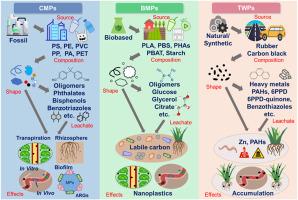Occurrence, fate, and ecological impacts of microplastics in soil: a comparative analysis of conventional, biodegradable microplastics, and tire wear particles
IF 7.3
2区 环境科学与生态学
Q1 ENVIRONMENTAL SCIENCES
引用次数: 0
Abstract
As plastic waste continues to build up in soil, the issue of microplastics (MPs) has become a global concern. However, there is much less information available on soil-associated MPs compared to aquatic MPs. Most of our knowledge about MPs is primarily based on research on conventional microplastics (CMPs), which may not apply to biodegradable microplastics (BMPs) and tire wear particles (TWPs). Unlike previous reviews that largely focused on CMPs in aquatic systems, this review integrates bibliometric and thematic analyses to comparatively examine CMPs, BMPs, and TWPs in soils, offering a new framework that highlights type-specific behaviors, ecological risks, and critical knowledge gaps. Bibliometric analysis reveals a shift from early emphasis on occurrence and identification toward growing concerns over ecological impacts and contaminant interactions. Thematic analysis summarizes published data about the occurrence, aging processes, and impacts on soil properties and biota, with a focus on the differences between the three types of MPs. Compared to CMPs, BMPs degrade more rapidly and destabilize soil elemental cycles, while TWPs release highly toxic leachates such as carcinogens and heavy metals, which will persist in fauna. The risks posed by BMPs and TWPs may be underestimated, and more research is needed to understand their environmental behavior and impacts. Persistent gaps remain in standardized monitoring, comparative ecotoxicological studies, and long-term field assessments, underscoring the urgent need for integrated, system-level risk evaluation of different types of soil MPs.

土壤中微塑料的发生、命运和生态影响:常规、可生物降解微塑料和轮胎磨损颗粒的比较分析
随着塑料垃圾在土壤中不断堆积,微塑料(MPs)问题已成为全球关注的问题。然而,与水生MPs相比,与土壤相关的MPs的可用信息要少得多。我们对微塑料的大部分知识主要是基于对传统微塑料(cmp)的研究,这可能不适用于可生物降解微塑料(bmp)和轮胎磨损颗粒(twp)。与以往主要关注水生系统中cmp的综述不同,本综述整合了文献计量学和专题分析,对土壤中的cmp、bmp和twp进行了比较研究,提供了一个新的框架,突出了特定类型的行为、生态风险和关键的知识空白。文献计量学分析揭示了从早期强调发生和识别到日益关注生态影响和污染物相互作用的转变。专题分析总结了已发表的关于MPs的发生、老化过程及其对土壤性质和生物群的影响的数据,重点分析了三种MPs之间的差异。与cmp相比,bmp降解更快,破坏土壤元素循环,而TWPs释放出致癌物和重金属等剧毒渗滤液,并在动物群中持续存在。bmp和twp所带来的风险可能被低估了,需要更多的研究来了解它们的环境行为和影响。标准化监测、比较生态毒理学研究和长期现场评估方面仍然存在差距,这突出表明迫切需要对不同类型的土壤MPs进行综合的系统级风险评估。
本文章由计算机程序翻译,如有差异,请以英文原文为准。
求助全文
约1分钟内获得全文
求助全文
来源期刊

Environmental Pollution
环境科学-环境科学
CiteScore
16.00
自引率
6.70%
发文量
2082
审稿时长
2.9 months
期刊介绍:
Environmental Pollution is an international peer-reviewed journal that publishes high-quality research papers and review articles covering all aspects of environmental pollution and its impacts on ecosystems and human health.
Subject areas include, but are not limited to:
• Sources and occurrences of pollutants that are clearly defined and measured in environmental compartments, food and food-related items, and human bodies;
• Interlinks between contaminant exposure and biological, ecological, and human health effects, including those of climate change;
• Contaminants of emerging concerns (including but not limited to antibiotic resistant microorganisms or genes, microplastics/nanoplastics, electronic wastes, light, and noise) and/or their biological, ecological, or human health effects;
• Laboratory and field studies on the remediation/mitigation of environmental pollution via new techniques and with clear links to biological, ecological, or human health effects;
• Modeling of pollution processes, patterns, or trends that is of clear environmental and/or human health interest;
• New techniques that measure and examine environmental occurrences, transport, behavior, and effects of pollutants within the environment or the laboratory, provided that they can be clearly used to address problems within regional or global environmental compartments.
 求助内容:
求助内容: 应助结果提醒方式:
应助结果提醒方式:


